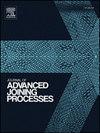Effect of cooling rate on metallurgical and mechanical properties in continuous wave laser welding of hot-dip galvanised steel-to-aluminium sheets in a zero part-to-part gap lap joint configuration
IF 3.8
Q2 MATERIALS SCIENCE, MULTIDISCIPLINARY
引用次数: 0
Abstract
Using a continuous wave (CW) laser with beam oscillation, this study elucidates the impact of passive and active cooling on welding hot-dip galvanised steel-to-aluminium sheets. The work investigates how cooling affects the formation of intermetallic compounds (IMCs) and the behaviour of Zn vapours, both of which are critical factors to the joint strength. IMCs are recognised as the most decisive factor in welding steel to aluminium, while Zn vapours significantly impact welding in a zero part-to-part gap overlap configuration. A 3D finite element method thermal model was employed to correlate the thermal cycles to the metallurgical and mechanical properties. The cooling rate without beam oscillation increased by 34% switching from passive to active cooling, while it was only 2.5% with oscillation present (2.5 mm lateral oscillation). Results revealed that active cooling influences Zn vapours and IMCs differently; faster cooling reduced total IMCs and Fe2Al5 phase and increased joint strength; however, it exacerbated spattering and weld discontinuity due to insufficient time for outgassing the Zn vapours from the molten pool. This adverse effect was more pronounced with beam oscillation due to larger molten pool. The experimental work also showed that despite beam oscillation does enlarge the connection area, the average shear stress was relatively lower compared to the case without oscillation, attributed to the increased thickness of the IMCs. Active cooling with water flow at 10 °C achieved 60% joint efficiency compared to parent aluminium, while beam oscillation reduced this to 54% but with half the strength variation. This highlights the complex, non-linear interplay between IMC formation, Zn vapour outgassing, and the dynamics of the molten pool.
冷却速率对零间隙搭接结构下热镀锌钢铝板连续波激光焊接冶金性能和力学性能的影响
本研究利用带光束振荡的连续波(CW)激光器,阐明了被动冷却和主动冷却对热镀锌钢铝薄板焊接的影响。这项工作研究了冷却如何影响金属间化合物(IMCs)的形成和Zn蒸气的行为,这两者都是接头强度的关键因素。IMCs被认为是钢与铝焊接中最具决定性的因素,而Zn蒸气在零部分到部分间隙重叠配置中显著影响焊接。采用三维有限元热模型分析了热循环与合金的冶金性能和力学性能之间的关系。无梁振荡时,从被动冷却到主动冷却的冷却速率提高了34%,而有梁振荡时(2.5 mm横向振荡)的冷却速率仅为2.5%。结果表明,主动冷却对Zn蒸气和IMCs的影响不同;快速冷却降低了总IMCs和Fe2Al5相,提高了接头强度;然而,由于没有足够的时间将锌蒸气从熔池中排出,这加剧了飞溅和焊接不连续。由于熔池较大,这种不利影响在光束振荡时更为明显。实验还表明,尽管梁的振动确实扩大了连接面积,但由于imc厚度的增加,平均剪应力相对于没有振动的情况相对较低。与母材铝相比,10°C水流的主动冷却可以实现60%的接头效率,而梁振荡可以将其降低到54%,但强度变化只有一半。这突出了IMC形成、Zn蒸气脱气和熔池动力学之间复杂的非线性相互作用。
本文章由计算机程序翻译,如有差异,请以英文原文为准。
求助全文
约1分钟内获得全文
求助全文

 求助内容:
求助内容: 应助结果提醒方式:
应助结果提醒方式:


